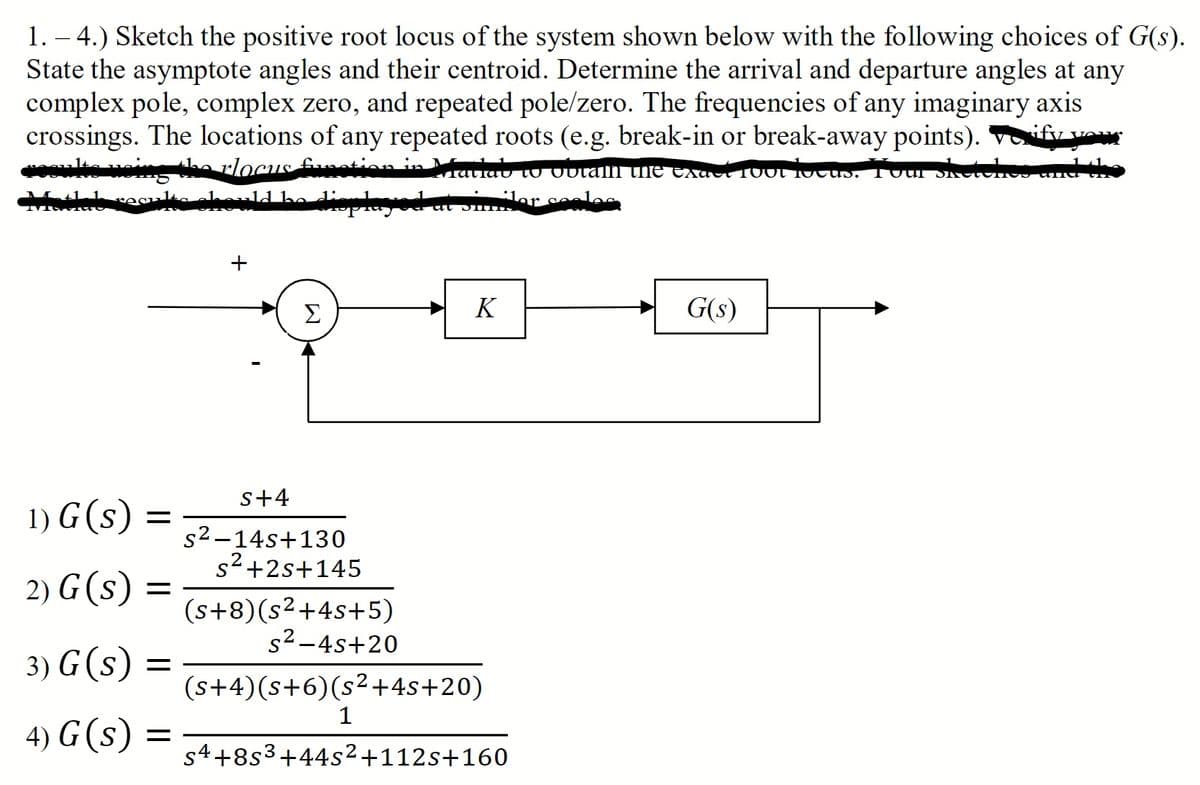1. – 4.) Sketch the positive root locus of the system shown below with the following choices of G(s). State the asymptote angles and their centroid. Determine the arrival and departure angles at any complex pole, complex zero, and repeated pole/zero. The frequencies of any imaginary axis crossings. The locations of any repeated roots (e.g. break-in or break-away points). keing the rlocus fationin skechuld be dioplayod ut ifv vew zatlau to obtalh tne Exa TOOL 1OCas. TOui Sec • 1ar seles + K G(s) s+4 1) G(s) s2-14s+130 s2+2s+145 2) G(s) = (s+8)(s²+4s+5) s2-4s+20 3) G(s) = (s+4)(s+6)(s²+4s+20) 1 4) G(s) = s4+8s3+44s²+112s+160
1. – 4.) Sketch the positive root locus of the system shown below with the following choices of G(s). State the asymptote angles and their centroid. Determine the arrival and departure angles at any complex pole, complex zero, and repeated pole/zero. The frequencies of any imaginary axis crossings. The locations of any repeated roots (e.g. break-in or break-away points). keing the rlocus fationin skechuld be dioplayod ut ifv vew zatlau to obtalh tne Exa TOOL 1OCas. TOui Sec • 1ar seles + K G(s) s+4 1) G(s) s2-14s+130 s2+2s+145 2) G(s) = (s+8)(s²+4s+5) s2-4s+20 3) G(s) = (s+4)(s+6)(s²+4s+20) 1 4) G(s) = s4+8s3+44s²+112s+160
Introductory Circuit Analysis (13th Edition)
13th Edition
ISBN:9780133923605
Author:Robert L. Boylestad
Publisher:Robert L. Boylestad
Chapter1: Introduction
Section: Chapter Questions
Problem 1P: Visit your local library (at school or home) and describe the extent to which it provides literature...
Related questions
Question

Transcribed Image Text:1. – 4.) Sketch the positive root locus of the system shown below with the following choices of G(s).
State the asymptote angles and their centroid. Determine the arrival and departure angles at any
complex pole, complex zero, and repeated pole/zero. The frequencies of any imaginary axis
crossings. The locations of any repeated roots (e.g. break-in or break-away points). Vify vo
rlocus Funotion n latiau to Outalh the Exaci 100t 10cus. T0ur
ld ha dieplayod at
ler seles
Σ
K
G(s)
s+4
1) G (s)
s2-14s+130
s2+2s+145
2) G (s)
(s+8)(s²+4s+5)
s2-4s+20
3) G(s)
=
(s+4)(s+6)(s²+4s+20)
1
4) G (s)
=
s4+8s3+44s²+112s+160
+
Expert Solution
This question has been solved!
Explore an expertly crafted, step-by-step solution for a thorough understanding of key concepts.
This is a popular solution!
Trending now
This is a popular solution!
Step by step
Solved in 5 steps with 5 images

Recommended textbooks for you

Introductory Circuit Analysis (13th Edition)
Electrical Engineering
ISBN:
9780133923605
Author:
Robert L. Boylestad
Publisher:
PEARSON

Delmar's Standard Textbook Of Electricity
Electrical Engineering
ISBN:
9781337900348
Author:
Stephen L. Herman
Publisher:
Cengage Learning

Programmable Logic Controllers
Electrical Engineering
ISBN:
9780073373843
Author:
Frank D. Petruzella
Publisher:
McGraw-Hill Education

Introductory Circuit Analysis (13th Edition)
Electrical Engineering
ISBN:
9780133923605
Author:
Robert L. Boylestad
Publisher:
PEARSON

Delmar's Standard Textbook Of Electricity
Electrical Engineering
ISBN:
9781337900348
Author:
Stephen L. Herman
Publisher:
Cengage Learning

Programmable Logic Controllers
Electrical Engineering
ISBN:
9780073373843
Author:
Frank D. Petruzella
Publisher:
McGraw-Hill Education

Fundamentals of Electric Circuits
Electrical Engineering
ISBN:
9780078028229
Author:
Charles K Alexander, Matthew Sadiku
Publisher:
McGraw-Hill Education

Electric Circuits. (11th Edition)
Electrical Engineering
ISBN:
9780134746968
Author:
James W. Nilsson, Susan Riedel
Publisher:
PEARSON

Engineering Electromagnetics
Electrical Engineering
ISBN:
9780078028151
Author:
Hayt, William H. (william Hart), Jr, BUCK, John A.
Publisher:
Mcgraw-hill Education,